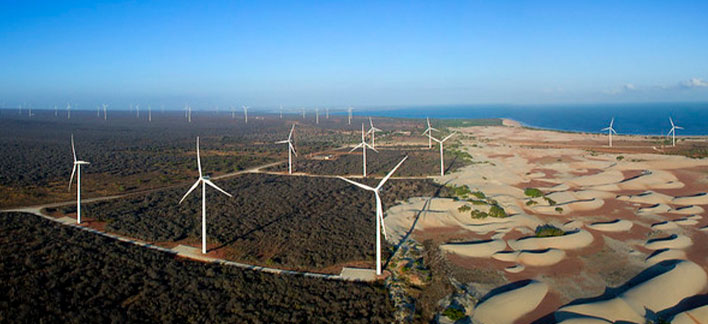
Strong wind season leads to record peaks in wind generation in Northeast
The so-called “high-wind season” phenomenon has begun in Northeast region of Brazil. During this period, from July to October, an increase in the quality and intensity of the winds is perceived due to the sea currents. As a result, record generation peaks are common, as wind farms make the most of these climatic conditions. Neoenergia has a contribution to this scenario, with its 44 wind farms, 17 in operation and 27 under construction, all of them in the Northeast. Thus, it accounts for around 5% of wind generation in the region, with 15% growth expected by 2022.
“The main energy generation source in Northeast stems from renewable resources, in this case, the wind energy. Due to this, by achieving all-time-highs in wind generation, the states in this region become less dependent on other energy sources, such as hydro and thermal source, and are able to be self-sufficient. In some periods of the year, wind generation exceeds the demanded load and thus, supply exceeds demand and the region becomes self-sufficient, even exporting the exceeding energy to other locations”, explains Neoenergia’s Renewables Operation and Maintenance (O&M) manager, Rodrigo Errera.
In the first week of August alone, the National System Operator (ONS) recorded three average energy generation records in Northeast. The latest occurred on August 6, when wind force produced 9,049 MWavg. This capacity is enough to supply the equivalent of 94.4% of the electric demand in all states of the regions. Other records were seen in August 5, with average wind energy generation of 8,854 MWavg and on August 2, with 8,780 MWavg.
CLIMATIC PHENOMENUM
Specifically in Brazilian Northeast, the improved quality of winds as regards to direction, speed and density is also influenced by the climatic phenomenon called El Niño. It is characterized by higher temperatures in Equatorial Pacific ocean, resulting in improved wind generation, as during these periods, rainfalls are lower in the region, favoring energy production from winds.
“In the months of July to October we have the best, more unidirectional winds in the year, that is, with minimal change in direction. This is very important for wind generation, as when wind change its route, the wind turbine must be adjusted, reducing its efficiency. In addition, during this period, wind achieves optimal speeds, over 12 meters per second, when a great part of the wind turbine models reaches their generation peaks”, says Errera.
SUSTAINABLE DEVELOPMENT
Neoenergia’s investment in wind generation is in line with the company’s commitment in contributing to combat climate change. “Wind is a clean and renewable energy source, with no pollutants resulting from its operation”. Therefore, the high-wind season optimizes the benefits of wind energy by leading to a larger reduction in greenhouse gases emission”, says Mariga.
Currently, the company has 17 wind farms in operation in the states of Bahia, Rio Grande do Norte and Paraíba, with Installed capacity around 516 MW - enough to supply over 1.1 million Brazilian households, avoiding emissions of more than 830 thousand tons of CO2 to the atmosphere. In two years, the company’s wind generation installed capacity will triplicate, reaching 1.6 GW. This will be possible with the completion of Chafariz (PB) complex, with 12 farms, adding 471.2 MW and Oitis (PI e BA) complex, with 15 farms, adding 566.5 MW to this total.
News
2025-04-22
Neoenergia vende 50% de Itabapoana Transmissão
2025-04-15
Nova campanha da Neoenergia celebra a potência feminina no esporte e reforça apoio às atletas embaixadoras da marca
2025-03-27
Instituto Neoenergia lança chamada inédita unificada de editais para apoiar projetos sociais
2025-03-21
Neoenergia é reconhecida entre as empresas mais exemplares do mundo em sustentabilidade
2025-03-14
